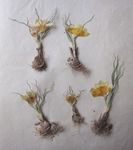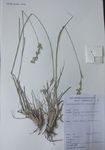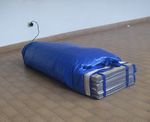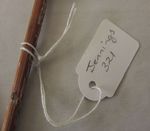Making herbarium specimens - Kew Gardens
←
→
Page content transcription
If your browser does not render page correctly, please read the page content below
Making herbarium
specimens
Technical Information Sheet_15 Laura Jennings, Roberta Hope and Xander van der Burgt, Royal Botanic Gardens, Kew
Herbarium voucher specimens are a vital species which is not visible on the dried with a sheet of cardboard to prevent the
part of a seed collection. They are used specimen, such as: specimens being pressed against the
to verify that seed has been collected • Desciption of location, including frame and becoming corrugated.
from the target species, and are valuable provinces and place names, a Place layers of blotting paper (blotters)
additions to herbarium collections in description of the site, GPS coordinates between the layers of newspaper
their own right. This information sheet (latitude and longitude) and altitude. containing your specimens to help draw
outlines how to collect, press and dry
• Description of habitat, ecology and moisture out of the plants.
herbarium specimens.
associated species.
Corrugated sheets of aluminium are
Before you start, ensure that you • Plant characteristics, such as habit, useful as they heat up and allow air to
adhere to international and local laws height, and any features that won’t flow through the press while it is being
concerning biological collections, survive in the dried specimen e.g. dried. Cushion them with blotting paper
and have the correct permits and the flower/fruit colour, smell of flowers or rather than placing them directly next to
landowner’s permission. leaves, presence/colour of latex. the specimens in newspaper, otherwise
Label each duplicate specimen with corrugations will be marked on the
the same collector name and collection specimens. Alternatively, use corrugated
number as your seed collection, so that cardboard with large enough air spaces
collections can be cross-referenced. to allow air flow through the press.
Herbarium data may be collected in Specimens are usually pressed in
different ways e.g. in a field notebook, sheets of newspaper, because this is
or on a field data sheet, if part of a seed absorbant, cheap, easily available almost
collection (see Technical Information everywhere and pre-folded. However,
Sheet_3). some botanists prefer to use “flimsies”
General Principles made from thin, strong and slightly
What is a herbarium specimen? absorbant paper. These may give better
Once you have collected your plant results for delicate specimens and in
A herbarium specimen (sometimes
specimen, it needs to be pressed and very dry environments.
called a voucher) is a dried, pressed
dried. This allows the specimen to be
plant (or parts of a plant) which acts Straps should be capable of being
mounted and preserved indefinitely in a
as a record of a species at a particular fully tightened, and withstanding a
herbarium. You should aim to:
time and place. Specimens are stored in lot of pressure (for example, a strap of
herbaria, and often collectors will send • Press the specimens as flat as propylene webbing with a metal buckle).
several duplicates (specimens of the possible, as this helps prevent them from
same species, made at the same time, being damaged and pieces breaking off When you have finished collecting,
from the same place as one another) to when they are stored. tighten the straps around the press so
different herbaria, for various uses. • Spread the different parts of the that specimens cannot move around
plant with as little overlap as possible, and leaves lie flat. Consider the amount
What to collect so that they all remain visible when the of pressure used: when pressing
You need to collect a typical sample specimen is mounted. woody plants, the straps may be firmly
of the species you are collecting seeds tightened. Pressing succulent herbs too
• Preserve delicate plant parts (like firmly may damage the specimen so
from. It needs to be representative of flowers) without crushing them, by
the population, but also of the individual straps should only be lightly tightened.
folding a piece of light greaseproof
plant you are collecting from. Select paper around them.
a plant which looks like an average of • Dry the specimen as quickly as
the population, and shows as many possible to preserve its colour, to
features you think may be useful during prevent disintegration and the growth
identification — herbarium specimens of mould.
must be fertile (have leaves, flowers or
fruit, and seeds), otherwise they may not Anatomy of a drying press
be identifiable to species.
Lay the wooden press frames so that
Recording data and labelling the longest slats are on the outside
of the press. This helps to distribute
As part of the collection, you need to pressure more evenly when the press is
record the data for the label which will tightened. Above: The arrangement of layers within a
be mounted with the specimen. This herbarium press, showing aluminium corrugates
provides useful information about the Line the inside of the wooden frame and blotters between specimens in flimsies
Millennium Seed Bank Partnership, Wakehurst Place,
Ardingly, West Sussex RH17 6TN, UK brahmsonline.kew.org/msbpobjects of varying sizes, so you will
need to fold and cut your specimen
accordingly. If the individual plants are
small, collect several individuals per
duplicate to make a complete collection.
Conversely, if the specimen is too large
for the newspaper, leaves and stems can
be folded or cut to fit.
Pressing large leaves
Leaves which are only slightly bigger
than the newspaper can be folded
with a small amount of overlap, for
example with the apex (leaf tip) folded
over. Leaves that are much larger
than the paper need to be cut into
sections, preserving the base, apex and
a section of the middle of the lamina
Above: Several small individual plants are needed
(leaf blade). You should record detailed to form a single duplicate
Above: A fertile specimen arranged on a sheet of measurements of the original size of the
newspaper, ready to be pressed leaf. In some cases a single collection
may need multiple sheets, e.g. if the Folding stems
Arranging specimens in the press plant has very large leaves and a large Stems must be folded to fit the size
inflorescence. of the paper, and should zig-zag
Remove soil and dirt from the specimens
and spread the leaves, fruit and flowers For compound leaves be careful to take vertically rather than across the page.
out within a folded sheet of newspaper. a specimen of the whole leaf, with a This is usually necessary with grasses
Turn over one of the leaves to show section of stem and an axial bud. You and sedges, which are often unwieldy.
the underside, and if there is enough may have to fold over the apex of the This should be done thoughtfully as
material, try and turn several flowers to leaf to make it fit in the newspaper, and the specimen eventually needs to be
show the morphology of the different also trim some of the leaflets. If you trim mounted and cannot be re-folded
sides. Keep the specimen within the the leaflets, leave the petiole and a small once it is dry. Bruising the stems with
sheet of newspaper, as pieces hanging piece of the leaf blade on the specimen a fingernail sometimes helps them
out of the press may be damaged, to show their position. bend. You can also secure the stems
broken off or not pressed properly. A in their folded position using slips of
standard herbarium sheet is about 27 paper with a slit cut in them. When you
cm x 42 cm, and the specimen should fold a specimen, place the root end
be slightly smaller than this to allow in the bottom left hand corner of the
for a border when it is mounted on a newspaper, and fold the stem slightly
herbarium sheet. below the top of the newspaper. If
necessary, fold several times.
Jeweller’s tags
As you press each specimen, write Below: Long grass stems are folded over so that
the collector’s name and number on the specimen fits on the sheet
a jeweller’s tag and loop the string It is important to show both sides of
loosely around the stem. Alternatively, flowers or floral heads as one side will
loop pieces of paper securely around be glued down when the specimen is
specimens if jeweller’s tags are not mounted.
available. This ensures that your
specimen stays associated with any It may also be useful to dissect or take
notes you made about the collection. cross sections of some plant structures,
If the press breaks and the specimens such as inside flowers, if these features
become loose, you will be able to are useful identifiers.
recover some if the collector’s name
and number are securely fastened to
the plant. Always write in pencil, which
doesn’t fade. Writing the collector’s
name and number on the bottom right
corner of the newspaper can also be
helpful for sorting the collections once
they are dried.
Herbarium sheets are a standard size,
while living plants are three-dimensional
Right: Collector’s name and number written on
a jeweller’s tag and looped around the stem of a
plant specimenBulky plant parts explained below, but must be constantly
monitored and a smoke detector should
If there are any parts of the specimen be suspended above the electric fan
that are significantly more bulky than heater.
the rest, pack paper around them in
the press so that the pressure remains Use an electric fan heater of around
evenly spread on the stack of specimens. 1000 kW, or a 2000 kW heater on a low
If any part of the specimen is more than heat setting. Secure a tarpaulin around
1 cm thick (e.g. taproots, large fruits), the fan heater and press, so that the
you should either slice it into sections tarpaulin inflates and the hot air passes
and press it as normal, or preserve it through the drying press. Use foldback
by an alternative method, for example clamps or staples to close any gaps.
by creating a carpological collection (a The drying press must be at least 20 cm
herbarium collection which is thicker Above: The preferred method of drying herbarium thick; if drying just a few specimens add
than about 2 cm, stored in a box rather specimens, using an electric fan heater empty corrugated sheets until minimum
than mounted on a sheet). Large fruits thickness is reached. Carpological
can be dried whole, by placing directly Drying Herbarium Specimens collections, e.g. large fruits, can be dried
on a metal corrugate and placing it in inside the tarpaulin.
Much like drying seeds (see technical
the drier. Be careful to label them with
the collector’s name and number on
information sheet_08), drying herbarium Drying over a portable gas burner
specimens is dependent on the
a jeweller’s tag, so that they can be If there is no reliable electricity supply,
ambient temperature and humidity, the
matched up with the leaves and stems portable gas burners can be used.
thickness of the plant material, the air
that you have pressed separately later. Suspend the drying press 0.5–1 m above
flow through the press, and the papers
used. The basic principle is to enable air the heat source by elevating on wooden
Duplicates boxes or hanging from a ceiling beam
at 37–60 oC to flow through the drying
Duplicates are when several herbarium press for 12–24 hours and then check or tree. Direct the heat (and protect the
specimens are made of the same species the specimens. press from rain) by wrapping a tarpaulin
for a single collection, so different around the press and stove, ensuring
institutions can have the same species After 24 hours of drying most specimens that air can exit from the top of the
record. They should be as similar as should be completely dry. At this point press. Use a fine metal wire mesh to
possible to one another. You should open the press, check all the specimens prevent plant material falling onto the
collect 3 to 6 duplicates of every and remove any which are dry. Replace burners. Make sure the flames cannot
herbarium specimen, one for the local wet blotting paper with dry blotters. At reach the tarpaulin or press; specimens
institution, one for a partner institution, this point if any specimens are still wet are very flammable, and overheating will
one for any regional or taxonomic they will be flexible enough that you can cause them to become brittle and lose
experts, and one for another large rearrange the leaves and fertile parts colour.
herbarium. This allows more botanists slightly, if there is too much overlap or
to see your specimens, and confirm your they are folded wrongly.
identifications. In hot dry climates where the ambient
environment provides a constant flow
Plants requiring special treatment of dry air at above 37 oC you will not
(seek specialist advice) need an external heat source, but you
• Aquatic plants: use perforated waxed will need to change the blotting papers
paper, or thin nylon or muslin fabric every 24 hours as usual. In colder or
to press (they will stick to newspaper more humid environments, you will
and flimsies). Use additional sheets of need to expose your press to an external
drying paper and change frequently. heat source, such as a drying room
For fully submerged plants collect into a
or oven. In the field, this may not be
plastic bag, keep in a fridge and take to a
specialist within a few days. available so you may need to improvise
heat sources such as those suggested
• Succulents: slice longitudinally and/
below.
or transversely, scoop out inner tissue.
Dry quickly, or alternatively preserve in Once dry, seal specimens in plastic so
alcohol. that they do not reabsorb moisture from
• Very large-leaved plants, for example the atmosphere, and your drying efforts
palms and Musaceae: collect sections are not wasted.
of leaves (base, middle and apex) and
inflorescence (all orders of branching). Drying with an electric fan heater
Fold to fit the press, label parts Above: Drying specimens over a gas fire. A metal
sequentially, take measurements and
This is the best method to dry herbarium cage prevents the tarpaulin getting too close to
make notes. specimens but it requires a reliable the heat source.
electricity supply and good quality
• Plants with underground parts: slice
lenthwise, press sections and kill with equipment. During the first hour of Use several small gas burners (between
alcohol (otherwise it may regrow). use regularly check that plugs and 1 and 4, depending on the size of the
cables are not overheating. Drying press to be dried) on their lowest heat
• Plants with complex 3D structures e.g.
orchids: preserve an example in alcohol herbarium specimens with an electric setting and adjust the temperature by
(see below). fan heater carries a much smaller risk adding or removing a burner. Change
of fire compared to the gas method gas cartridges as necessary: the gasTechnical Information Sheet_15
cartridges listed in the equipment Left: A stack of unmounted dried specimens ready
specification burn for 12 hours at the for shipping
lowest heat setting, therefore cartridges
can be changed morning and evening. Equipment to take into the field
Drying over a charcoal fire • Tools for cutting: secateurs, pole
pruners, pruning saw.
The drying press can be suspended over • Gloves to protect against thorns,
a charcoal fire, but care must be taken irritant hairs or latex
that smoke does not pass through the
press. If the fire produces too much • Field press in a bag: cardboard,
newspaper, straps.
smoke, suspend the press inside an oil Sending Herbarium Specimens
drum cut into two halves. • Jeweller’s tags
It is important that specimens are sent
• GPS, manual and spare batteries
Short term preservation in alcohol to herbaria unmounted. This is because
most herbaria will have their own ways • Field notebook, pencil
If you are away from drying facilities of mounting and specifications around
for several days and cannot use a field • Camera
what size and type of paper specimens
method of drying, specimens left in a are to be mounted on. Specimens do • Dissection kit with scalpel, forceps
press for days will start to disintegrate not need to be secured to the paper in • Hand lens
and make very poor specimens. In this order to be transported, and sellotape
case the Schweinfurth alcohol method Equipment kept at base
should never be used on any part of a
might be necessary. The specimens herbarium specimen as its removal will • Full drying press with wooden frames,
(still in the press) are placed in a strong damage the specimens. blotting paper, metal corrugates and
plastic bag, 0.5 litres of 60%–80% straps.
alcohol is added, and the bag is tightly Specimens should be fully dried before • 1 kW electric fan heater, gas stove, or
sealed until the specimens can be dried sending as this will make them more other device to expose press to a steady
by the usual method. able to withstand the journey. Send flow of air at 37–60oC
each specimen in its own piece of dry
The alcohol method should only be newspaper, ensuring collection numbers Further reading
used as a last resort as it makes inferior are still attached. Put stiff cardboard
specimens. Specimens preserved in Bridson, D. (2000) The Herbarium Handbook.
at the top and bottom of the stack of Royal Botanic Gardens, Kew.
this way will be discoloured, the plant specimens, and tie securely with string.
chemistry will be changed (for example Victor, J.E., Koekemoer, M., Fish, L., Smithies,
Pack specimens flat and horizontally, S. J., & Mössmer, M. (2004) Herbarium
oils and waxes may be dissolved) and
essentials: the southern African herbarium
their DNA may be adversely affected. and take care to ensure the parcel
user manual. Southern African Botanical
remains that way up during transit. Diversity Network Report No. 25. SABONET,
Preserving 3D structures Fill any spaces in the box with packing Pretoria. Available from: https://www.
If your specimen has fruit or flowers material to reduce the amount the sanbi.org/wp-content/uploads/2018/04/
where retaining their three-dimensional specimens will move. You should always sabonet-report-no-25-herbarium-essentials-
structure is important for identification send the relevant data with specimens southern-african-herbarium-user-manual.
(e.g. orchids), you can preserve them in (see above). pdf (26/07/18)
70% alcohol. Place the specimen inside If your specimen is crossing country Queensland Herbarium, (2016). Collection
a leak-proof bottle or plastic bag, cover and preserving plant specimens, a manual.
borders you must check import/ 2nd edition. Department of Science,
with alcohol and seal tightly. Specimens export legislation. Some families (such
preserved in spirit will lose their colour, Information Technology and Innovation,
as Orchidaceae) are also subject to Brisbane. Available from: https://www.qld.
so take notes and photographs to record regulation under the Convention on gov.au/environment/assets/documents/
this. Specimens preserved in alcohol International Trade in Endangered plants-animals/herbarium/collecting-
may not be permitted on airlines. Species (CITES). manual.pdf (26/07/2018)
Equipment specifications
Hand lens (x10 or x20 Folding magnifier in case
magnification www.agarscientific.com
Description Model and Supplier
Secateurs Felco Model No. 2 Original
Global positioning system unit GARMIN GPSMAP 64
www.worldoffelco.co.uk
(GPS) and maps www.garmin.com
Jeweller’s tags Locally available
Herbarium drying press Herbarium plant press and nylon
webbing straps
Portable gas burner Campingaz 206 stove and C206 single
www.herbariumsupply.com
use gas cannisters
Blotting papers Locally available Locally available
Corrugated aluminium or www.herbariumsupply.com Leather gloves Locally available
cardboard ventilators
Heavy gauge plastic bags Locally available
Electric Fan Heater 1000kW or 2000kW with adjustable
heat setting Dissection kit Scalpel, forceps of different sizes/types
Locally available www.fisher.co.uk
Field Press www.herbariumsupply.com Tarpaulin Locally available
Please note that the above equipment is used by the Millennium Seed Bank and has been chosen carefully using our many years’ experience. The list of suppliers is for guidance only and does not represent an
endorsement by the Royal Botanic Gardens, Kew. The manufacturer’s instructions must be followed when using any of the equipment referred to in this Information Sheet .
© Copyright 2018, Board of Trustees of the Royal Botanic Gardens, Kew Printed on 100% recycled paperYou can also read



























































